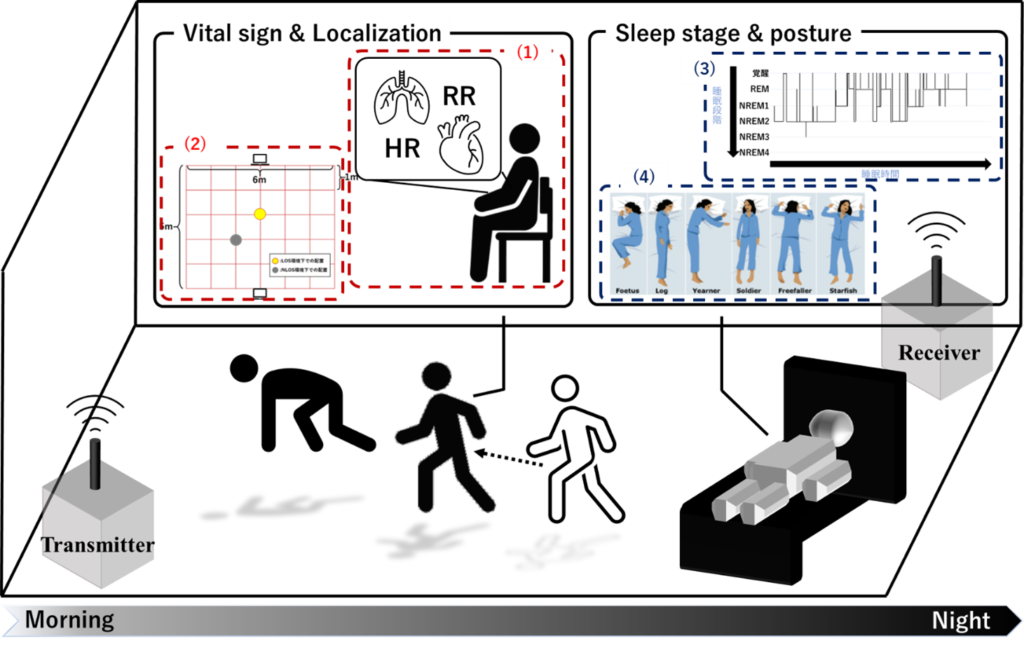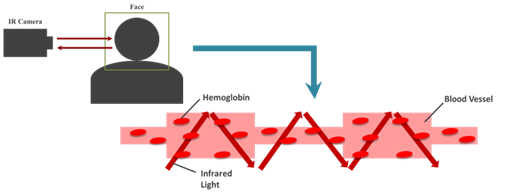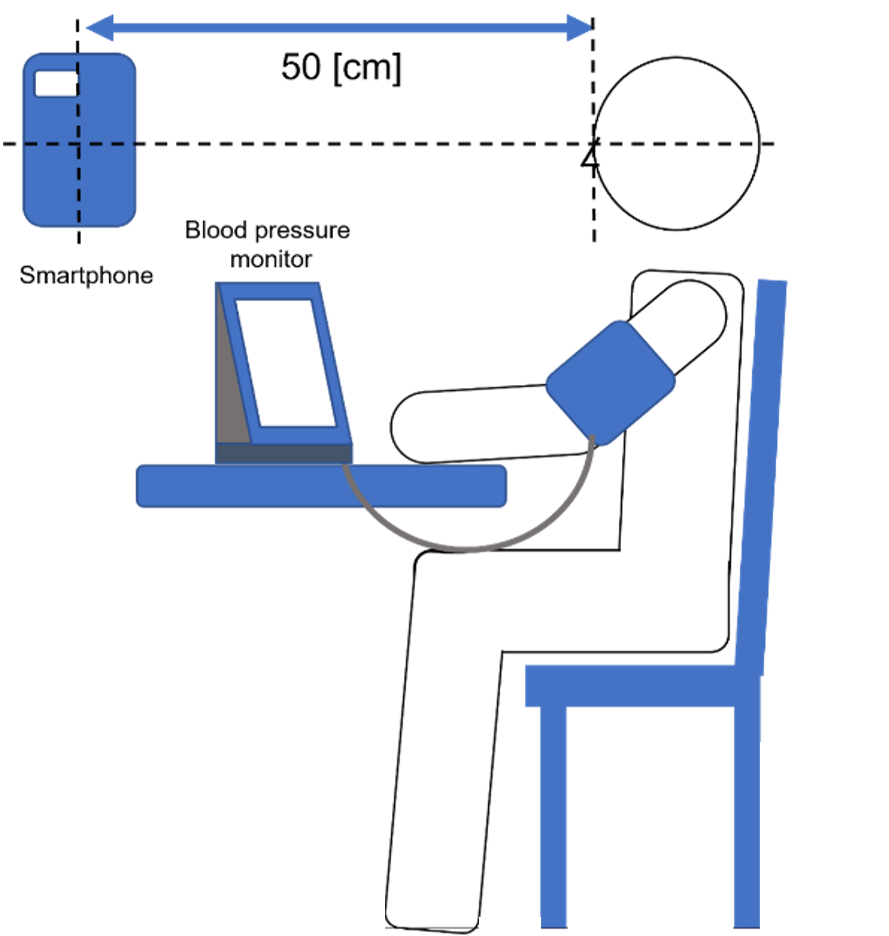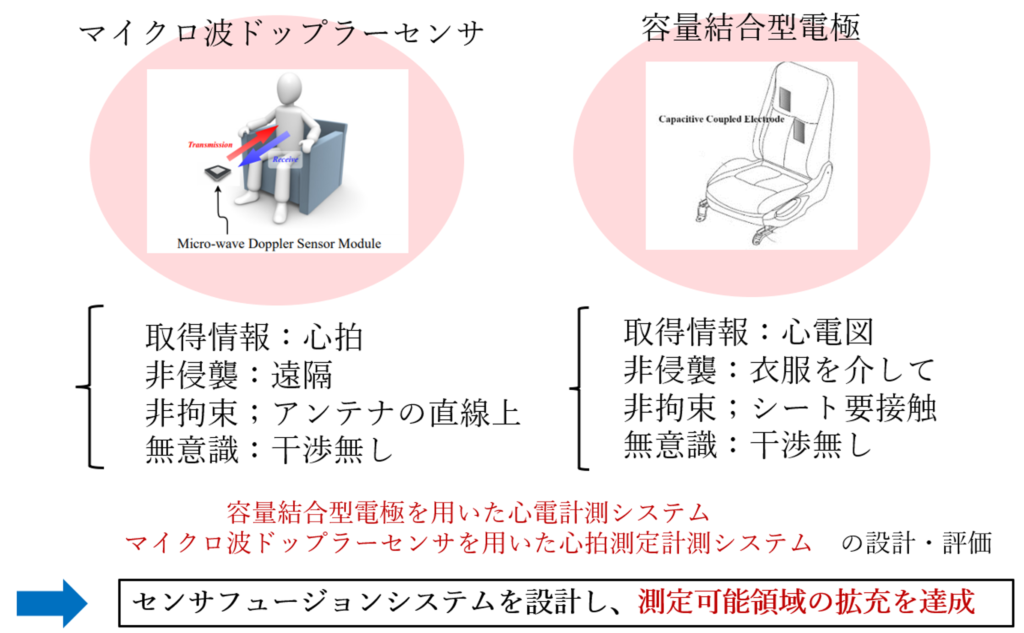Vital sensing using Wi-Fi channel state information

This research is developing a sensor that uses a commercially available Wi-Fi device to acquire biometric information of a person in a fixed space in a non-contact manner. Although Wi-Fi is generally used for data communication, this research treats Wi-Fi as a physical radio wave and analyzes the obtained channel state information to estimate various types of biometric information. The three major categories of systems in this research are “sleep stage estimation system based on respiratory rate, heart rate, and body movement,” “complete non-contact blood pressure estimation system,” and “indoor location information estimation system. The sleep stage estimation system enables approximately 99% estimation of respiration rate and heart rate, as well as highly accurate and highly trackable estimation of body movement. The indoor location estimation system cannot accurately estimate the radio propagation time (ToF), but the use of the Fresnel zone has made it possible to overcome this limitation.
Kazuya Tsubota, Yuki Nagatsu, Hideki Hashimoto, “Biometric Information Acquisition System Using VMD in Wi-Fi Channel Status Information,” IECON2021-47th Annual Conference of the IEEE Industrial Electronics Society
志賀駿也, 坪田和也, 長津裕己, 橋本秀紀, “Wi-Fiチャネル状態情報を用いた人の屋内位置推定システムの検討”, ロボティクス・メカトロニクス講演会2022 in Sapporo
Non-contact heart rate and blood pressure estimation using a camera

In recent years, it has become possible to measure heart rate from wearable devices. However, they are still contact-type devices, and their discomfort makes it difficult to apply them during sleep, so contactless devices are preferred. Therefore, this research is developing a non-contact, real-time system for estimating a person’s heart rate using a commercially available infrared camera. Generally, heart rate measurement using a camera observes minute color changes on the skin surface. However, accurate estimation is difficult due to unconscious body motion noise caused by breathing and other factors. Therefore, we improved the accuracy by using signal processing that combines multiple filters. Since this research uses an infrared camera, it can be applied during sleep and can be used to determine the state of sleep.

Heart rate and blood pressure are vital signs, and their measurement is of critical significance. We are conducting research on unrestrained blood pressure estimation using camera-based sensing technology and machine learning. In existing studies, blood pressure was estimated by extracting characteristic parameters of pulse wave extracted from video images and using regression learning, but since this method is prone to disturbance, Distance PPG was used in the pulse wave extraction process in order to increase SNR. These studies are expected to improve the convenience of measurement in non-medical settings.
Keisuke Terai, Yuki Nagatsu, Hideki Hashimoto “ Improvement in Noncontact Heart Rate Measurement Accuracy via Infrared Camera Considering Body Movement During Sleep ”, Sensing, Actuation, Motion Control, and Optimization (SAMCON2022) 2022.3, Saitama(Online), p.173-178
Keita Hirano, Keisuke Terai, Yuki Nagatsu and Hideki Hashimoto, “IPPG BP Estimation Model Considering Hydrostatic Pressure”, 2022 IEEE 4th Global Conference on Life Sciences and Technologies, 2022.3, Osaka, Japan,(online), pp.361-365
Development of a non-invasive electrocardiogram measurement system combining a capacitively coupled electrode and a microwave Doppler sensor

Capacitive coupled electrocardiography systems can sense electrocardiograms even when the subject is wearing clothing, thus enabling more physiological information to be obtained from the subject. However, capacitive coupled electrocardiography systems also have disadvantages. For example, the sensing environment is restricted to a limited space, and the number and type of clothing worn can affect sensing accuracy. In contrast, it has been reported that a heartbeat sensing system using a microwave Doppler sensor can accurately sense the subject’s external factors. In this study, we improved the performance of a capacitively coupled electrocardiographic system and designed a Heart Rate sensing system using a microwave Doppler sensor, and by fusing two sensors in a range where sensing is impossible with only a single sensor, we were able to obtain missing physiological information, thereby making it possible to measure the subject. The system will expand the range of measurement possibilities for subjects by acquiring physiological information that is missing by fusing two sensors in a range that cannot be sensed by a single sensor alone.
Keita Sado, Yusuke Deguchi, Yuki Nagatsu, Hideki Hashimoto “Development of Magnetic Absolute Encoder Using Eccentric Structure : Improvement of Resolution by Multi-Polarization” IEEE/ASME International Conference on Advanced Intelligent Mechatronics
Ryoto Fujita,Yuki Nagatsu,Hideki Hashimoto, “Proposal of a Method for Non-Contact Electrocardiogragh Measurement System by Sensor Fusion”, Sensing, Actuation, Motion Control, and Optimization (SAMCON2022), 2022.3, Saitama(Online), p.173-178
Silent Speech Recognition Considering the Effects of Walking on EMG

In recent years, with the development of voice recognition systems and smartphones, technologies for remote control of home appliances have attracted much attention. In addition, communication using a contactless input method is useful as a countermeasure against pandemics such as infectious diseases, but there are some issues to be solved, such as the need to speak and the need to remove a mask. However, the use of electromyograms to recognize the content of speech without uttering a voice enables communication that does not depend on the person using the device and is not restricted by the location. In this research, we focus on speech recognition while walking, which is difficult with conventional methods, and propose a method to eliminate body motion during walking. The proposed method can be used in any situation in daily life.
池田弘樹, 大平峻, 橋本秀紀, “筋電位による歩行時の影響を考慮した無声発話認識”, 第23回計測自動制御学会システムインテグレーション部門講演会, 3A2-A14, 2022.12,
